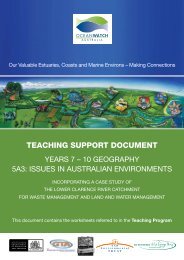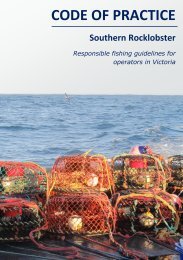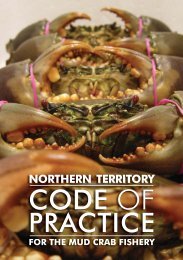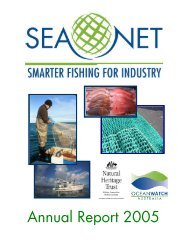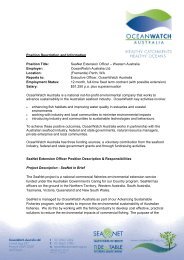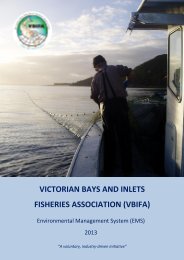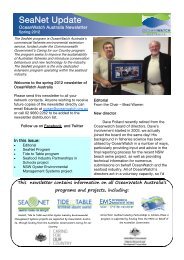SeaNet September 2011 - OceanWatch Australia
SeaNet September 2011 - OceanWatch Australia
SeaNet September 2011 - OceanWatch Australia
Create successful ePaper yourself
Turn your PDF publications into a flip-book with our unique Google optimized e-Paper software.
The <strong>SeaNet</strong> program is <strong>OceanWatch</strong> <strong>Australia</strong>’s commercial fisheries<br />
environmental extension service, funded under the Commonwealth<br />
Government’s Caring for our Country program. The<br />
program seeks to<br />
improve the sustainability of <strong>Australia</strong>n fisheries and introduce<br />
conservation behaviours and new technology to the industry. The<br />
<strong>SeaNet</strong> program is the only dedicated extension program operating<br />
within the seafood industry.<br />
Welcome to the Spring <strong>2011</strong> Report of <strong>OceanWatch</strong> <strong>Australia</strong><br />
Please send this newsletter to all your network contacts. Anyone wishing ihi to receive future copies of the<br />
newsletter directly can email Eduardo at ocean@oceanwatch.org.au or call 02 9660 2262 to be added<br />
to the newsletter distribution list.<br />
Working with fishermen to advance<br />
the sustainability of <strong>Australia</strong>’s<br />
seafood industry.<br />
IN THIS ISSUE:<br />
• State roundup from your local <strong>SeaNet</strong> Extension Officer<br />
• Tide to Table roundup<br />
• Seafood Industry Partnerships in Schools<br />
• NSW Oyster Industry Environmental Management Syst<br />
tems<br />
Follow <strong>OceanWatch</strong> on Facebook or visit us at<br />
www.oceanwatch.org.au
State roundup from your local <strong>SeaNet</strong> Officer<br />
Northern Territory<br />
Lyn Lambeth<br />
Cleaning Up Darwin Harbour<br />
The second Darwin Harbour Clean-Up day was held on Tuesday, July 5, and<br />
once again was successful in bringing together a range of stakeholders to do<br />
something positive for Darwin Harbour and hopefully raise awareness of<br />
rubbish issues in our marine environment.<br />
Around 90 volunteers and workers got involved from a diverse range of<br />
government, non-government and private agencies. These included Paspaley<br />
Pearls, NT Fisheries, NT Water Police, Darwin Port Corporation, Parks and<br />
Wildlife Junior Rangers, and Surf Life Saving NT. Eight boats were out on the<br />
water, seven land-based crews collected rubbish around Darwin as well as on Cox Peninsula, and a dive team<br />
from the Museum and Art Gallery Northern Territory went to see what they could find in Lake Alexander (not<br />
much).<br />
Just over a tonne of general rubbish was collected including eight tyres, several chairs, 150 metres of fishing<br />
line, 4500 plastic bags, 5200 aluminium cans, 1700 drink bottles, 1900 pieces of cardboard (mainly fireworks<br />
which contain plastic inside the cardboard) and 63 thongs.<br />
The amount of general rubbish collected in most hotspots, especially common items such as aluminium cans<br />
and plastic bottles, was comparable to what was collected during last year’s clean-up day. A 14 th video,<br />
showing all the action from the clean-up day, has been added to the <strong>SeaNet</strong> NT YouTube site,<br />
www.youtube.com/user/<strong>SeaNet</strong>NT. y<br />
The <strong>SeaNet</strong> NT videos have now had over 20000 views.<br />
The “mini clean-up” team at Nightcliff.<br />
In <strong>September</strong> a “mini clean-up” was organised with the NT <strong>SeaNet</strong> Officer and the Project Officer from<br />
GhostNets <strong>Australia</strong> working with Junior Rangers from<br />
Kormilda College on a marine debris survey around<br />
Nightcliff Jetty. The Junior Ranger program at the College is designed to introduce indigenous students to<br />
science and the students not only collected rubbish but also sorted, counted and recorded their results on<br />
data sheets.<br />
OHS & QI Material for the Post Harvest Sector<br />
As part of a project funded by the Fisheries Research and Development Corporation, <strong>SeaNet</strong> Officers are<br />
distributing information and resource materials on Seafood Quality & Occupational Health and Safety (OH&S)<br />
materials to the Post Harvest Sector. The resource ma<br />
aterials include information on a Quality Index and an<br />
OH&S package developed by the Sydney Fish Market. To date, the information package has been delivered<br />
to the majority of those holding an NT Trader/Processor licence and to retailers providing fresh seafood.<br />
More information?<br />
www.oceanwatch.org.au
A Crab Trip: Rolling out the newly-revised Code of<br />
Practice of the NT mud crab fishery<br />
On a recent trip to the Western Gulf region, the NT <strong>SeaNet</strong> Officer spent a week with mud crab fishermen at<br />
Roper River, Limmin River, Borroloola, King Ash Bay and the Wearyan River. The aim of the trip was to<br />
distribute and explain the newly-revised Code of Practice for the fishery to introduce fishermen to the<br />
concept of Environmental Management Systems and<br />
gain further input into the draft. This is part of a two<br />
year project funded under the <strong>Australia</strong>n Government’ ’s Caring for our Country.<br />
Limmen River Fishing Camp, Gulf of Carpentaria.<br />
Lyn Lambeth <strong>SeaNet</strong> Northern Territory PH: 08 8981 5194 or 0421 054 274<br />
lyn@oceanwatch.org.au<br />
South <strong>Australia</strong><br />
Nathan Bicknell<br />
SA Seafood Awards <strong>2011</strong><br />
<strong>September</strong> the 8 th marked the <strong>2011</strong> biannual SA Seafood Awards hosted by<br />
the SA Women’s Industry Network (SAWIN) at the Port Lincoln Hotel.<br />
Congratulations to the SAWIN for delivering a great night which was enjoyed<br />
by all (into the wee hours). <strong>OceanWatch</strong> <strong>Australia</strong>’s Executive Chairman, Mr.<br />
Brad Warren, was a keynote speaker providing an engaging introduction to the<br />
award winning Seafood Partnerships in Schools (SIPS<br />
S) program piloted in<br />
Tasmania 2010/<strong>2011</strong> (watch this space in SA).<br />
Brad Warren, <strong>OceanWatch</strong> <strong>Australia</strong>’s Executive Chair, at the <strong>2011</strong> SA Seafood Awards.<br />
More information?<br />
www.oceanwatch.org.au
<strong>SeaNet</strong> SA was a partner in two projects nominated for two award categories including:<br />
•Environmental-Seafood for the Future -The Gulf St. Vincent Bycatch reduction System (GSV BRS)<br />
•Promotion-Where Does Seafood Come From?<br />
Showing positive signs for the SA seafood industry, these two categories were both hotly contested and<br />
we were honoured to be runners up in each. These results are a great acknowledgement from our peers<br />
and proof that with lateral thinking and a co-operativee approach much can be achieved with limited<br />
resources. For further information on the night and the winners follow the link to the SA WIN website:<br />
www.sawin.org.au. The SA “Where Does Seafood Come From” series and development and performance<br />
of “the GSV BRS” can be found on <strong>OceanWatch</strong> <strong>Australia</strong>’s website:<br />
http://www.oceanwatch.org.au/publications-and-videos/oceanwatch-videos/<br />
Port Festival <strong>2011</strong> (8 th & 9 th October)<br />
To commemorate and celebrate the contribution of seafood to the culture and heritage of South <strong>Australia</strong>,<br />
the <strong>Australia</strong>n Maritime and Fisheries Academy proudly presented the inaugural “Complete Seafood<br />
Experience” as an integral part of the <strong>2011</strong> Port Festival program. For detailed information on the event<br />
and the festival follow the link: http://www.portenf.sa.gov.au/page.aspx?u=1994<br />
The Complete Seafood Experience (CSE)<br />
The focus of this event was to return the Port to its working by showcasing the<br />
state’s iconic seafood produce and fair, providing a unique insight into the people<br />
and organisations which help deliver quality sustainable seafood produce from<br />
ocean to plate.<br />
The Event Management Committee Update<br />
We are happy to report that the CSE reached its ambitious target of 36 stalls and<br />
would like to take this opportunity to thank the state’ss seafood community for<br />
supporting the event making it a true representation of the people and<br />
organisations working to ensure SA is a world leader in fisheries management and<br />
procurement. Special thanks to Event Management C<br />
Committee champions Franca<br />
Romeo (WFS/PISC) and Maureen Jones (AMFA) for their tireless and loveless<br />
work behind the scene which has laid a strong foundation for success in <strong>2011</strong> and<br />
bigger and better things in the future.<br />
Nathan Bicknell <strong>SeaNet</strong> South <strong>Australia</strong> PH: 08 8303 2717 or 0401 997 702<br />
nathan@oceanwatch.org.au<br />
New South Wales<br />
Michael Wooden<br />
Sydney Fish Market Seafood Awards<br />
<strong>OceanWatch</strong> <strong>Australia</strong>, NSW <strong>SeaNet</strong> and South Westt Rocks Fishers Limited (SWRF)<br />
were recently nominated for an Environmental Excellence Award at the Sydney Fish<br />
Market Seafood Awards night in Sydney’s Town Hall. . <strong>SeaNet</strong> and SWRF were highly<br />
commended for their efforts in improving sustainability in the NSW Ocean Haul<br />
Fishery as well as engaging and educating the community. Additionally, <strong>SeaNet</strong> and<br />
SWRF received a congratulatory correspondence from<br />
the NSW DPI for their efforts<br />
to promote the sustainability of the fishery with the Loaves and Fishes Barbeque.<br />
More information?<br />
www.oceanwatch.org.au
Congratulations to the Broken Bay Oyster Farmers from<br />
the Hawkesbury River for receiving the<br />
Environmental Excellence award. Broken Bay Oyster farmers have demonstrated environmental<br />
excellence, with concerted efforts to improve their catchment, including the removal of derelict<br />
infrastructure from the river, increased community engagement, implementing the <strong>SeaNet</strong> facilitated<br />
Environmental Management System, uptaking new technologies, and improving practices.<br />
Congratulations also to the South East Trawl Fishing Industry Association (SETFIA) whom were highly<br />
commended for the Environmental Skipper Training course. The training was successful in improving<br />
awareness of the environmental stewardship role that the commercial fishing industry plays. <strong>SeaNet</strong><br />
Officers from NSW, Victoria and Tasmania presented information to fishers as part of the training,<br />
regarding the role that the fishing industry plays to minimise potential translocation of exotic marine pest<br />
species. Congratulations to all the fishermen who weree involved in the training.<br />
NSW Rapid Pipi Assessment<br />
NSW <strong>SeaNet</strong> Officer, NSW DPI Fisheries Manager and a NSW Commercial Hand Gathering Fisherman<br />
conducted a one week ‘Rapid Pipi Assessment’ during<br />
August from Port Macquarie through to Tweed<br />
Heads. The assessment examined abundance and size<br />
composition of pipi from the low to high water<br />
mark. On all beaches surveyed, juvenile and adult pipi (Plebidonax deltoides) were located and<br />
photographed. To view a short explanatory video, visit<br />
the <strong>OceanWatch</strong> YouTube account and click on<br />
the NSW <strong>SeaNet</strong> Rapid Pipi Assessment video (http://www.oceanwatch.org.au/publications-and-<br />
videos/oceanwatch-videos/).<br />
Michael Wooden <strong>SeaNet</strong> New South Wales PH: 02 9660 2262 or 0422 618 248<br />
michael@oceanwatch.org.au<br />
South East Queensland<br />
David Kreutz<br />
Clean-ups in Important Fish Habitat<br />
Spring cleaning of fish habitat areas has been an underlying theme. Clean-ups at<br />
Hays Inlet and Tin Can Bay brought together a large range of interest groups. I know<br />
Patrick and Michelle will give you more details in their reports but I just wanted to<br />
thank the mighty volunteers in my group A at Hays Inlet who picked up an<br />
impressive 41 bags of rubbish.<br />
Seafood Festivals on the Calendar<br />
Seafood Festivals are also a major part of our spring calendar. Hervey Bay in early August was the biggest<br />
and best that I have seen in the 6 years that I have attended and is a stunning example to others of how to do<br />
it. The crowd exceeded 12000 stretching Fishermans park to its limit. Great interest was shown by the crowd<br />
More information?<br />
www.oceanwatch.org.au
in the fisherman’s stage where Pam and Des Findlay demonstrated sustainable practice and interviewed<br />
real fishers. The crowd was also able to ask questions. Special thanks should go to Elaine Lewthwaite,<br />
Michelle Fuchs and their organisation team who did a faultless job organising this showcase of local<br />
sustainable seafood to the community.<br />
Tin Can Bay Seafood festival was also impressive, whilst not quite the scale of Hervey bay. <strong>OceanWatch</strong><br />
had its display tailored to our partners from Wetland care and Burnet Mary Regional Group. A lot of<br />
interest was generated in the displays by young and old. Net maker Wally Hill dropped by and helped me<br />
give a talk about how a prawn net works to a group of people. They were intrigued at the technical<br />
aspects of net making and BRDs; we also debunked some myths about the amount of bycatch associated<br />
with prawn trawls.<br />
Working Cooperatively<br />
I have also been involved in a go slow area project that is being led by Queensland Seafood Industry<br />
Association (QSIA) in partnership with the Departmentt of Resource management and the fishers of the<br />
Great Sandy area. Mapping of turtle and dugong habitat is occurring with fisher’s unique knowledge of the<br />
area. I was also able to assist in the rodeo of 50 turtles throughout the straits and the deployment of 6<br />
satellite tags on green turtles to determine their foraging areas. The impact and affect of these go slow<br />
zones as well as management options are also being explored.<br />
Exclusion Zone<br />
Finally on a sour note, Fisheries Queensland has imposed a 500 km exclusion zone to all fishing around<br />
Gladstone harbour in central Queensland, being an unprecedented step. Sick Fish, Turtles and Dugongs<br />
have been found in the Harbor for months and warnings from commercial fishers were ignored. Some<br />
fishers have been hospitalized and the 40 million dollar local industry has been paralysed. Ongoing testing<br />
is yet to determine if the massive dredging project in the harbor is contributing, the initial ban is in place<br />
for 21 days. My thoughts are with the fishers affected<br />
and I have offered any assistance to the QSIA that I<br />
can give.<br />
David Kreutz <strong>SeaNet</strong> Southern Queensland PH: 07 5447 9491 or 0432 683 147<br />
david@ocean<br />
nwatch.org.au<br />
Far North Queensland<br />
David Schubert<br />
Hinchinbrook Seafood Industry Incorporated (HSII):<br />
Boosting the sustainability<br />
profile<br />
The HSII held their AGM recently, amongst the many topics discussed one in<br />
particular stood out to me; boosting the HSII’s sustainability profile to the broader<br />
community. I have been liaising with the Jensen family, who mostly fish for mud<br />
crabs as TC Yasi kindly submerged their Reef Line vessel.<br />
We have been discussing the use of Quick Response Codes. Quick Response Codes (QR codes) are<br />
widely used as a promotion tool in Japan. These black<br />
and white square codes are designed to be read<br />
using smart phone camera technology free software (see http://www.i-nigma.com/i-nigmahp.html) or<br />
search your smart phone application store for your freee program. The QR code immediately links the phone<br />
and customer to a corresponding online multimedia. The black and white QR code can be easily printed<br />
onto packaging, menus or placed onto fish monger pro<br />
oduce tags. With the popularity of smart phones in<br />
<strong>Australia</strong> this marketing tool is predicted to expand domestically and the HSII and in particular the Jensen<br />
family want to get ahead of the game and start trialling<br />
this technology now.<br />
More information?<br />
www.oceanwatch.org.au
Within the next month the QR code should be hitting the Sydney Fish Market on the<br />
Jensen’s boxes of Mud crabs. The code will be linked up to a video displaying the<br />
sustainability profile and the process undergone by the<br />
fisherman to land the product<br />
from boat to belly. The video will be part of <strong>SeaNet</strong>’s ‘Telling the story’ initiative, ideally<br />
there will be a series of videos for each of the fisheries within the HSII. Why not<br />
download your y code reader app and have a look. Along<br />
g with the Q QR codes, , the HSII are<br />
currently updating their webpage www.hinchinbrookseafood.com and have designed<br />
new stickers for all shipments of product.<br />
Greg Jensen of the HSII - Showing off a couple of nice bucks<br />
whilst filming for the QR code video.<br />
Quality Index and Occupational Health and Safety Roll-out<br />
R out<br />
Over the past three months I have seen plenty of the Bruce Highway visiting the multitude of seafood<br />
processors, retailers and wholesalers situated in the North, for the delivery and extension of the QI and<br />
OH&S project. I have travelled down to Ilbilbie, South of Mackay to the North side of Cairns, covering over<br />
1000Km of the East Coast.<br />
Nylon Monofilament Recycling Program in Conjunct<br />
ion with GhostNets <strong>Australia</strong><br />
GhostNets <strong>Australia</strong> recently contacted <strong>SeaNet</strong> NQ with the news of a potential net recycling initiative. The<br />
aim is to collect commercial fisher’s old, unusable nylon monofilament nets, store them until there is a bulk<br />
load and ship them off to a secret location where the nylon will be recycled. If you are a net fisher in the<br />
NQ region, expect a phone call within the upcoming months.<br />
If you are interested in the project or would like to donate your old nets, feel free to contact me using my<br />
details below, and I will arrange a time to pick them up<br />
free of charge.<br />
Barra, Beef and Bulldust Expo: Karumba 4 th -6 th November<br />
Only one more month until the annual Barra, Beef and Bulldust Expo held in Karumba. The expo will<br />
promote sustainability of the Gulf region’s community, environment, culture and economy by showcasing<br />
projects, services, tourism and businesses, not to mention <strong>OceanWatch</strong> <strong>Australia</strong> will be hosting a stand in<br />
conjunction with commercial fishers of the Gulf, which<br />
will be highlighting:<br />
•Informational Signs on each fishery in the area;<br />
•Different nets and fishing apparatus for the community<br />
to interact with;<br />
•A laptop displaying <strong>OceanWatch</strong> <strong>Australia</strong>’s video library;<br />
•A variety of log books and legislative info for the public<br />
to see, to show how the fishery is managed; and<br />
•Information on <strong>OceanWatch</strong> <strong>Australia</strong>, our <strong>SeaNet</strong> program along with past and present projects.<br />
David Schubbert <strong>SeaNet</strong> Far North Queen<br />
nsland PH: 07 4773 7226 or 0409 347 495<br />
dave@oceanwatch.org.au<br />
More information?<br />
www.oceanwatch.org.au
Western <strong>Australia</strong><br />
Jay Shoesmith<br />
New <strong>SeaNet</strong> Extension Officer<br />
Jay holds a Bachelor of Administration (Marine Resource Management)<br />
majoring in Fisheries Management from the <strong>Australia</strong>nn Maritime College in<br />
Tasmania. He has experience as a research technician working for Fisheries<br />
Queensland, as a deckhand in the tourist sector at a resort, and as a<br />
volunteer at the Queensland State Emergency Service. He has spent time at<br />
sea, as well as doing lab work, working cooperatively with commercial<br />
fishermen and the post harvest sector.<br />
Seafood Industry Awards<br />
<strong>OceanWatch</strong> <strong>Australia</strong> sponsored the Environment Award at the <strong>2011</strong> WA Seafood Industry Awards, held<br />
on Friday 19 August at the Swan Yacht Club in Fremantle. The prize went jointly to the Challenger Institute<br />
of Technology and Austral Fisheries. These two WA based ventures have been notorious for their<br />
contribution to environmental sustainability; the former for the development p of waste management g systems y<br />
in the aquaculture sector, whereas the latter for its contribution to the Heard Island and McDonald Islands<br />
Marine Reserve as well as the Macquarie Island Marine Reserve.<br />
Jay Shoesmith <strong>SeaNet</strong> Western <strong>Australia</strong> PH: 08 9432 7777 or 0401 838 436<br />
jay@oceanwatch.org.au<br />
Tasmania<br />
Anita Paulsen<br />
Well what a start!<br />
I have had an amazing journey over the past two months and it has been busy<br />
busy. Like my interstate team mates I have travelled port to port to deliver<br />
Occupational Health and Safety and Quality Index tool examples to the post<br />
harvest sector of the industry. The tools were developed by Seafood Standards<br />
<strong>Australia</strong> and the Sydney Fish Market to assist processing and post harvest<br />
operators with staff inductions as well as assessing the shelf life of whole scalefish.<br />
Julie McLaughlin of Seafoods Tasmania checking out the OH&S and QI Tools.<br />
This also presented an opportunity to network with some of my previous industry colleagues and discuss<br />
food safety policies as well. The operators in Tasmania demonstrated a high level of commitment to these<br />
issues and were interested in engaging g g g in conversations particularly about OH&S and many y indicated a<br />
desire to source the staff induction DVD and workbook. I am also following up some gaps that were<br />
identified with a small number of participants. Thank you to those operators that made time during what I<br />
know to be a hectic schedule. For those of you I missed I still have packs available including some fantastic<br />
Hazard Man stickers for your workplace, just drop me<br />
a line.<br />
Anita Paulsen <strong>SeaNet</strong> Tasmania PH: 03 6224 2890 or 0407 135 637<br />
anita@oceanwatch.org.au
Victoria<br />
Stevee Hay<br />
Sustainability: Disentangling myths from facts<br />
Spring has sprung (apparently in some countries) and our fancies turn<br />
to.....BBQs, good seafood and the beach.....but do we really take the time to<br />
question where our seafood comes from and the peop<br />
le who supply it year<br />
round regardless of the weather (no matter how consistently cold it is down our<br />
way)?<br />
In a movement that is slowly building momentum, people ARE asking where their seafood comes from and<br />
perhaps more importantly to the industry, how sustainable it is. Unfortunately there are a number of sources<br />
out there who are more than happy to push their agend<br />
da regardless of the validity of their “facts” . Luckily for<br />
the industry, an established sparring partner in the form<br />
of the <strong>Australia</strong>n Conservation Foundation has<br />
dispensed with the hyperbole and joined forces with Seafood Industry Victoria, <strong>SeaNet</strong>, University of<br />
Technology Sydney and Melbourne University to produce a rigorous and scientifically tested sustainability<br />
guide, of which part two will be released in the summer months...just in time for Christmas.<br />
On that note there seems to be an increasing number of platforms to highlight sustainability and food security<br />
issues and where the industry and community sits with<br />
this as a whole. Some of my “Spring” duties include<br />
speaking at an open forum on food security and sustainability at the Victorian Royal Agricultural Society show<br />
where I will be highlighting the industry’s contribution (largely unacknowledged) to feeding the populace and<br />
the care, science and excellent management practices they employ. As a warm up, that will prime me for the<br />
Melbourne University led Public Forum on Sustainable seafood in early November. Chaired by Dr. John Ford,<br />
the focus will be on sustainable practices, addressing green washing and hidden agendas and answering<br />
questions the mainstream media are not interested in answering. Dr. Ford has asked members from the<br />
scientific, management and industry sectors to particip<br />
pate. No NGOs have been asked to participate. p Just the<br />
facts m’am.<br />
Codes of Practice<br />
That said, SIV has suggested that <strong>SeaNet</strong> participates in its vetted rock lobster code of practice, which,<br />
though in draft form, will be an important piece that will only reinforce the excellent industry practice already<br />
in place. Hopefully this will send a clear message to the<br />
powers that be, that the seafood industry is a very<br />
important and vital part of not just the community or state, but <strong>Australia</strong> itself. Therefore deserving of funding<br />
for research, codes of practice and even just to let the <strong>Australia</strong>n public know that though quiet, fisherman<br />
have never gone away, complained or gone on strike. They have provided <strong>Australia</strong>n families with the finest<br />
quality and sustainable seafood, arguably, in the world and shall continue to do so.<br />
Seafood Festivals and Community Engagement: Telling the story<br />
As the Victorian <strong>SeaNet</strong> officer I will also be attending the numerous agricultural and seaside festivals up and<br />
down our beautiful coastline...giving me ample opportunity to call in have a chat and discuss any issues you<br />
would like to air. Having attended the last Seafood Industry Victoria (SIV) annual meeting, the members joked<br />
that everything was plodding along fine and Victoria need a crisis just to give everyone something to do...and I<br />
do mean joked. This is a great reflection that Victorian fishermen, state wide, regardless of their target are<br />
doing it right.<br />
Back down to earth, I have been assaulting the airwaves most weekends or contributing to local papers on<br />
the benefits of buying local, buying fresh. It appears to be a message that most people not just care about but<br />
are acting upon. With all the doom and gloom in the news, hopefully the tide will turn back to not only<br />
supporting our fishermen but acknowledging the respect they deserve. Watch this space for community<br />
events from Portland to Lakes Entrance that highlight the importance that the fishing community holds around<br />
this State.<br />
Steve Hay <strong>SeaNet</strong> Victoria PH:<br />
03 9329 5660or 0421 415 973<br />
steven@oceanwatch.org.au<br />
More information?<br />
www.oceanwatch.org.au
Tide to Table roundup<br />
Program Manager- Aquatic Habitat Rehabilitation<br />
/ Sydney Regional Landcare Facilitator<br />
Simon Rowe<br />
Meeting our Post Harvest Seafood Sector: Widening <strong>SeaNet</strong> horizons<br />
Occupational Health and Safety and Quality Assurance<br />
of product are two topics <strong>SeaNet</strong><br />
officers have recently been extending information on as part of a Fisheries Research and<br />
Development Corporation (FRDC) project. The roll-out<br />
process has now been completed,<br />
(except in WA) covering over 15% of the post harvest sector nationally. A total of 1904<br />
outlets were door knocked, including cooperatives, wholesalers and retailers with officers<br />
receiving a wide variety of responses.<br />
Talking assessment of quality product, recent studies funded by both the FRDC and<br />
Seafood Cooperative Research Centre identified Quality as a major relevant issue for the<br />
seafood industry. The increased costs of living has meant consumers are becoming heavily<br />
focused on receiving Quality food. In addition, waste and spoilage are factors associated<br />
with sustainability and bottom line profits for the fishmonger. The Quality Index manual helps<br />
identify for a number of species spoilage signs and rates, although a common skill of your<br />
average successful fishmonger perhaps a marketing advantage using a scientifically backed<br />
standard?<br />
Considering injury at work, it is widely recognised thatt the post harvest sector receives its<br />
fair share of accidents when it comes to slips, trips, falls, strains and puncture wounds. A<br />
series of reminder stickers and factsheets on the topic<br />
for managers are available for free<br />
from your local <strong>SeaNet</strong> officer. It is a demanding workplace and I would expect to see more<br />
happening in this space in the coming years.<br />
If you have missed out on any of the above free resources contact your local <strong>SeaNet</strong> officer<br />
while both the DVD for $50 and QI manual $300 are available from the Seafood Services<br />
<strong>Australia</strong> website to purchase (www.seafood.net.au).<br />
Simon Rowe PH: 02 9660 2262 or 0434 351 977<br />
simon@oceanwatch.org.au<br />
More information?<br />
www.oceanwatch.org.au
Queensland-Bundaberg<br />
Michelle Haase<br />
<strong>September</strong> has been all about partnerships for the Tide to Table Queensland<br />
program and south-east Qld <strong>OceanWatch</strong> staff, with Michelle, Patrick and Dave<br />
Kreutz working collaboratively to coordinate two successful marine debris clean-ups<br />
at Hays Inlet and Tin Can Bay. The clean-ups involved aswatheofstakeholders stakeholders, and<br />
included the following:<br />
•The Moreton Bay Seafood Industry Association and other seafood industry<br />
stakeholders;<br />
•Community groups such as the Cooloola Dragonboat Club, Southern Sandy Straits Marine Environment<br />
Group, Pine Rivers Catchment Association, Redcliffe Environmental Forum and Osprey House Environmental<br />
Centre;<br />
•The Department of Environment and Resource Manage<br />
ement (DERM);<br />
•The Department of Employment, Economic Development and Innovation (DEEDI),<br />
•Maritime Safety Qld;<br />
•Local councils - Gympie Regional Council and Moreton<br />
Bay Regional Council;<br />
•NGO’s such as Conservation Volunteers <strong>Australia</strong> and Wetlandcare <strong>Australia</strong>;<br />
•NRM groups - Burnett Mary Regional Group and SEQ Catchments; and<br />
•Private contractors that donated their services – namely Cooloola Skips at Tin Can Bay, Samies Seafood<br />
Market and Colliers Crane Hire in Brisbane.<br />
The level of community and government support for the<br />
clean-ups has been encouraging, and testament to<br />
the need for further work to remove marine debris to mitigate impacts of litter and large debris on marine<br />
habitats. Combined, the two clean-ups removed in excess of 9.5 tonnes of debris from declared Fish Habitat<br />
Areas that support the local seafood industry.<br />
In another show of support for partnership driven projec<br />
cts to enhance fish habitats, DEEDI and Bundaberg<br />
Regional Council completed the construction of a ‘nature-like fishway’ at Baldwin Swamp this month.<br />
<strong>OceanWatch</strong> negotiated the project to be constructed by DEEDI, funding a third of the cost of construction<br />
with funds from the <strong>Australia</strong>n Government’s Caring for our Country initiative, whilst DEEDI and Bundaberg<br />
Regional Council contributed to the remaining construction expenses.<br />
The fishway is a series of pools and riffles replicating the<br />
structure of a natural creek or stream, hence the<br />
term ‘nature-like fishway’. It mitigates a barrier to fish passage caused by a weir on Bundaberg Creek, and<br />
restores connectivity between 1.6 kilometres of brackish<br />
habitat to 3 kilometres of freshwater habitat. It’s<br />
significant to the local seafood industry because it creates more habitat in the highly modified Burnett River<br />
estuary for commercially desirable, migratory fish species such as sea mullet, barramundi, mangrove jack and<br />
jungle perch.<br />
Construction of fishway to connect Baldwin Swamp with Bundaberg Creek. This project included the<br />
construction of a “riverbed” and water passages to reestablish free movement of fish along this water way.<br />
Michelle Haase More Qld information?<br />
Tide to Table Program Manager PH: 07 4181 2999 or 0401 890 069<br />
michelle@oceanwatch.org.au<br />
www.oceanwatch.org.au
Southeast Queensland<br />
Patrick Sachs<br />
The start of the Queensland Tide to Table program in Moreton Bay has been full speed<br />
ahead since the hiring of Project Officer, Patrick Sachs at the end of June <strong>2011</strong>. Jumping<br />
straight into the role Patrick has launched the “improving<br />
coastal hotspots” project in<br />
Moreton Bay. The main ecological objective of the program is to improve water quality and<br />
fish habitat with its success revolving around funding on-ground actions and behaviour<br />
change activities that involve local landholders, farmers, the seafood sector and government<br />
agencies. <strong>OceanWatch</strong> <strong>Australia</strong>, through funding from the <strong>Australia</strong>n Government’s Caring for our Country<br />
program, is implementing a devolved grants program to attract proposals from community, industry and<br />
government groups to perform on-ground works to improve water quality and fish habitat. Grant applications<br />
closed Friday, <strong>September</strong> p 16 th and will be assessed over<br />
the coming g weeks.<br />
Simon Rowe (front) with volunteers from the Moreton Bay Seafood<br />
Industry Association, SEQ Catchments, DERM and the local<br />
community.<br />
Spring g has started really well for South East Queensland<br />
and Moreton Bay. <strong>September</strong> 1 st and 2 nd saw the<br />
Hays Inlet Marine Debris Cleanup in Griffin coincide with<br />
beautiful weather and a midday high tide to allow<br />
volunteers access to the cleanup site in the mangroves. This two day operation involved 15 groups that<br />
donated their time, expertise, resources and determination to get the job done. Six local and state<br />
government agencies including Maritime Safety Queensland, Fisheries Queensland, QLD Boating and<br />
Fisheries Patrol, the Moreton Bay Marine Park, Moreton Bay Regional Council and the Department of<br />
Environment and Resource Management; six environmental groups including Conservation Volunteers<br />
<strong>Australia</strong>, the Redcliffe Environmental Forum, Pine Rivers Catchment Association, SEQ Catchments,<br />
WetlandCare <strong>Australia</strong> and the Osprey House Environmental Centre; and three industry groups including<br />
the Moreton Bay Seafood Industry Association, Samies Girl Seafood Market and Colliers Crane Hire made<br />
the operation an incredible success.<br />
With such a great turnout, our volunteers were able to remove over seven tonnes of debris from a stretch of<br />
mangroves less than two kms long! Much of the large debris was left over from January’s floods and<br />
included three pontoons, three refrigerators, numerous tyres and other large debris you would never expect<br />
to see in the mangroves. A total of 127 bags of rubbish were collected on the Friday by volunteers and<br />
three large trucks, donated by the Moreton Bay Regional Council, were filled.<br />
A special thankyou goes to all our volunteers and groups that made the first two days of spring such a<br />
success. Three more cleanups will be happening in Moreton Bay during the next year so keep your ears<br />
open.<br />
Patrick Sachs SEQ Tide to Table Project Officer PH: 0488 087 772<br />
patrick@oceanwatch.org.au<br />
More information?<br />
www.oceanwatch.org.au
Seafood Industry Partnerships in Schools<br />
Project Officer - Tasmania<br />
Jennifer Hemer<br />
Educational partnerships between school classes, commercial fishermen and marine farmers<br />
continued to flourish over the winter. The Montrose Big<br />
Picture School participated in a tour<br />
of the Mures processing factory in southern Tasmania. School Advisor Amanda Sutton said<br />
‘having the opportunity to visit a successful food business in our local community was great’.<br />
Montrose Big Picture School students touring the Mures<br />
Processing Facility in Glenorchy, Tasmania.<br />
On Monday October 3 rd the SIPS program hosted an information session in Hobart for teachers, commercial<br />
fishermen and marine farmers. The purpose of the SIPSS Session was to enable people from industry and<br />
education to come together in a relaxed environment (the pub) to discuss how industry can be represented in<br />
education; to enlighten the broader community about issues affecting the industry and to discuss career<br />
pathways and opportunities for young people into the industry.<br />
Jennifer Hemer Seafood Industry Partnerships in<br />
Schools Project Officer PH: 0428 026 356<br />
jennifer@oceanwatch.org.au<br />
NSW Oyster Industry Environmental Management Systems<br />
Project Officer - NSW<br />
Andy Myers<br />
The future of the oyster industry depends not only on a healthy environment, but also on the<br />
ability to demonstrate that growers are utilising the environment in a responsible and<br />
sustainable manner. One way of doing this is to develop<br />
an Environmental Management<br />
System (EMS) to show how environmental risks, impacts and opportunities are managed.<br />
The process of EMS development allows oyster farmers<br />
to identify risks arising from internal, on-farm activities<br />
and also from external, catchment-based activities. This<br />
risk assessment process can then be used to prioritise<br />
remedial actions, reducing farmers’ exposure to risk by building resilience into their business.<br />
Development of EMS: Through this project, four new oyster industry EMS are currently under development<br />
covering the Nambucca River, Manning River, Port Stephens (Tilligerry Creek) and Brisbane Water. Two<br />
existing EMS are also being reviewed for Broken Bay Pe<br />
earls and the oyster farmers of the Clyde River. These<br />
EMS are evolving well, although progress has slowed recently due to the processing of applications tied to the<br />
Environmental Improvement Grants (see below).<br />
More information?<br />
www.oceanwatch.org.au
Environmental Improvement Grants: The response of the oyster industry, land-holders and catchment groups<br />
to the grants has been overwhelming. With $374k to devolve through the round, the process was heavily<br />
oversubscribed and received over 200 applications, requesting a cumulative total of $1m. The vast majority<br />
(90%) of applications from oyster farmers concerned infrastructure conversion projects, highlighting the<br />
aspirations of the industry to move away from tar and treated timber to more sustainable cultivation practices.<br />
Applicants are currently in the process of being notified of the outcome of their applications, with the view of on-<br />
ground work commencing in November.<br />
CNN Eco-Solutions: In late July, <strong>OceanWatch</strong> was contacted by a reporter from CNN interested in producing a<br />
short article highlighting the intrinsic link between oystering and the environment. After working up a concept<br />
with the reporter, a film crew arrived in mid-August from<br />
Hong Kong to undertake a day of filming. Despite<br />
filming for a full-day, the editorial lasts 4 minutes and will soon be aired on the Eco-Solutions program via the<br />
CNN global g network; an average g of 75 million people p p tune in to view the show. The article is also available<br />
online, and can viewed at:<br />
http://www.oceanwatch.org.au/our-work/ems-nsw-oysters/<br />
Discussing oyster farming in the Hawkesbury for CNN.<br />
Paul Crock (Environmeats) presenting at the Batemans<br />
Bay oyster industry field day<br />
NSW Oyster Industry Field Days: Organised by NSW Farmers, oyster industry field days have just been held<br />
at Port Macquarie and Batemans Bay. Focused on industry, the days provided the opportunity for farmers to<br />
meet and talk with trade suppliers, and to learn about relevant projects and research. <strong>OceanWatch</strong> took this<br />
opportunity to discuss estuary-wide EMS, and the development of an NSW oyster EMS database (see below).<br />
We also prompted proactive farmers to discuss their experiences developing these documents before<br />
introducing Paul Crock from Enviromeats in Victoria. Enviromeats is essentially a cooperative of beef farmers,<br />
with all those operating under the brand committed to environmental best practice. With an EMS consistent<br />
with international standards (ISO 14001), the talk allowed oyster guys to learn about another industry’s<br />
approach to environmental stewardship and their very successful marketing strategy.<br />
International Oyster Symposium: Hosted by the Oysters Tasmania and the World Oyster Society, the<br />
symposium was an excellent opportunity for oyster farmers, researchers and government bodies from around<br />
the world to discuss all things oysters; from production and industry risks through to marketing and<br />
consumption. <strong>OceanWatch</strong> presented a poster at the event, highlighting the NSW industry’s approach to<br />
managing risk through the development of EMS. The concept of taking an estuary wide approach to EMS<br />
development was well received by delegates, and the forum provided an excellent opportunity to discuss the<br />
risks impacting on farmers in other states.<br />
EMS Database: The NSW Oyster Industry EMS Database is now online. This interactive website allows users<br />
to explore the coast and identify those estuaries that are<br />
committed to an EMS. With the farmers authorisation<br />
it is hoped that the database will soon be able to provide<br />
direct access to EMS, giving the public and other<br />
farmers the ability to view these documents. http://www.oceanwatch.org.au/our-work/ems-nsw-oysters/ems-<br />
database/<br />
Andy Myers NSW Oyster Industry Environmental Management Systems Project Officer<br />
PH: 02 9660 2262 or 0488 656 3666 Email: andy@oceanwatch.org.au





